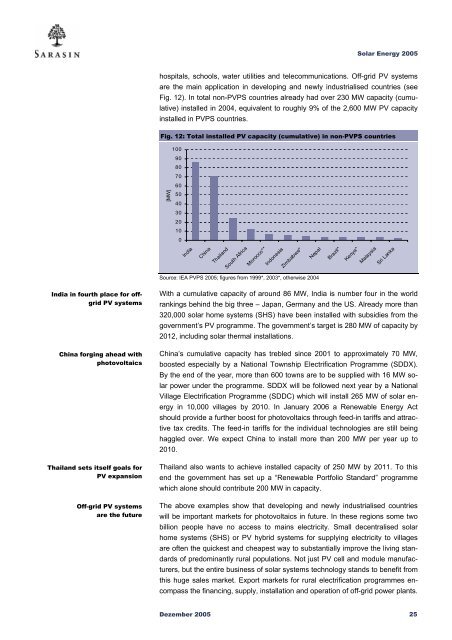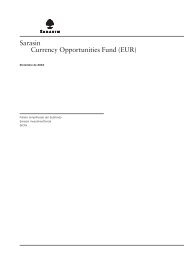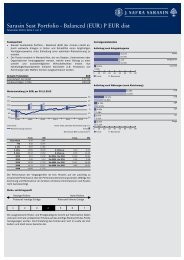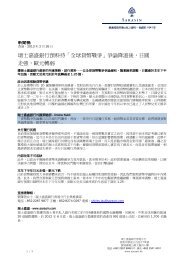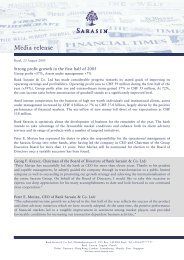Sustainability Report - Bank Sarasin-Alpen
Sustainability Report - Bank Sarasin-Alpen
Sustainability Report - Bank Sarasin-Alpen
You also want an ePaper? Increase the reach of your titles
YUMPU automatically turns print PDFs into web optimized ePapers that Google loves.
Solar Energy 2005<br />
hospitals, schools, water utilities and telecommunications. Off-grid PV systems<br />
are the main application in developing and newly industrialised countries (see<br />
Fig. 12). In total non-PVPS countries already had over 230 MW capacity (cumulative)<br />
installed in 2004, equivalent to roughly 9% of the 2,600 MW PV capacity<br />
installed in PVPS countries.<br />
Fig. 12: Total installed PV capacity (cumulative) in non-PVPS countries<br />
100<br />
90<br />
80<br />
70<br />
60<br />
[MW]<br />
50<br />
40<br />
30<br />
20<br />
10<br />
0<br />
India<br />
China<br />
Thailand<br />
South Africa<br />
Morocco**<br />
Indonesia<br />
Zimbabwe*<br />
Nepal<br />
Brazil*<br />
Kenya*<br />
Malaysia<br />
Sri Lanka<br />
Source: IEA PVPS 2005; figures from 1999*, 2003*, otherwise 2004<br />
India in fourth place for offgrid<br />
PV systems<br />
China forging ahead with<br />
photovoltaics<br />
Thailand sets itself goals for<br />
PV expansion<br />
Off-grid PV systems<br />
are the future<br />
With a cumulative capacity of around 86 MW, India is number four in the world<br />
rankings behind the big three – Japan, Germany and the US. Already more than<br />
320,000 solar home systems (SHS) have been installed with subsidies from the<br />
government’s PV programme. The government’s target is 280 MW of capacity by<br />
2012, including solar thermal installations.<br />
China’s cumulative capacity has trebled since 2001 to approximately 70 MW,<br />
boosted especially by a National Township Electrification Programme (SDDX).<br />
By the end of the year, more than 600 towns are to be supplied with 16 MW solar<br />
power under the programme. SDDX will be followed next year by a National<br />
Village Electrification Programme (SDDC) which will install 265 MW of solar energy<br />
in 10,000 villages by 2010. In January 2006 a Renewable Energy Act<br />
should provide a further boost for photovoltaics through feed-in tariffs and attractive<br />
tax credits. The feed-in tariffs for the individual technologies are still being<br />
haggled over. We expect China to install more than 200 MW per year up to<br />
2010.<br />
Thailand also wants to achieve installed capacity of 250 MW by 2011. To this<br />
end the government has set up a “Renewable Portfolio Standard” programme<br />
which alone should contribute 200 MW in capacity.<br />
The above examples show that developing and newly industrialised countries<br />
will be important markets for photovoltaics in future. In these regions some two<br />
billion people have no access to mains electricity. Small decentralised solar<br />
home systems (SHS) or PV hybrid systems for supplying electricity to villages<br />
are often the quickest and cheapest way to substantially improve the living standards<br />
of predominantly rural populations. Not just PV cell and module manufacturers,<br />
but the entire business of solar systems technology stands to benefit from<br />
this huge sales market. Export markets for rural electrification programmes encompass<br />
the financing, supply, installation and operation of off-grid power plants.<br />
Dezember 2005 25


